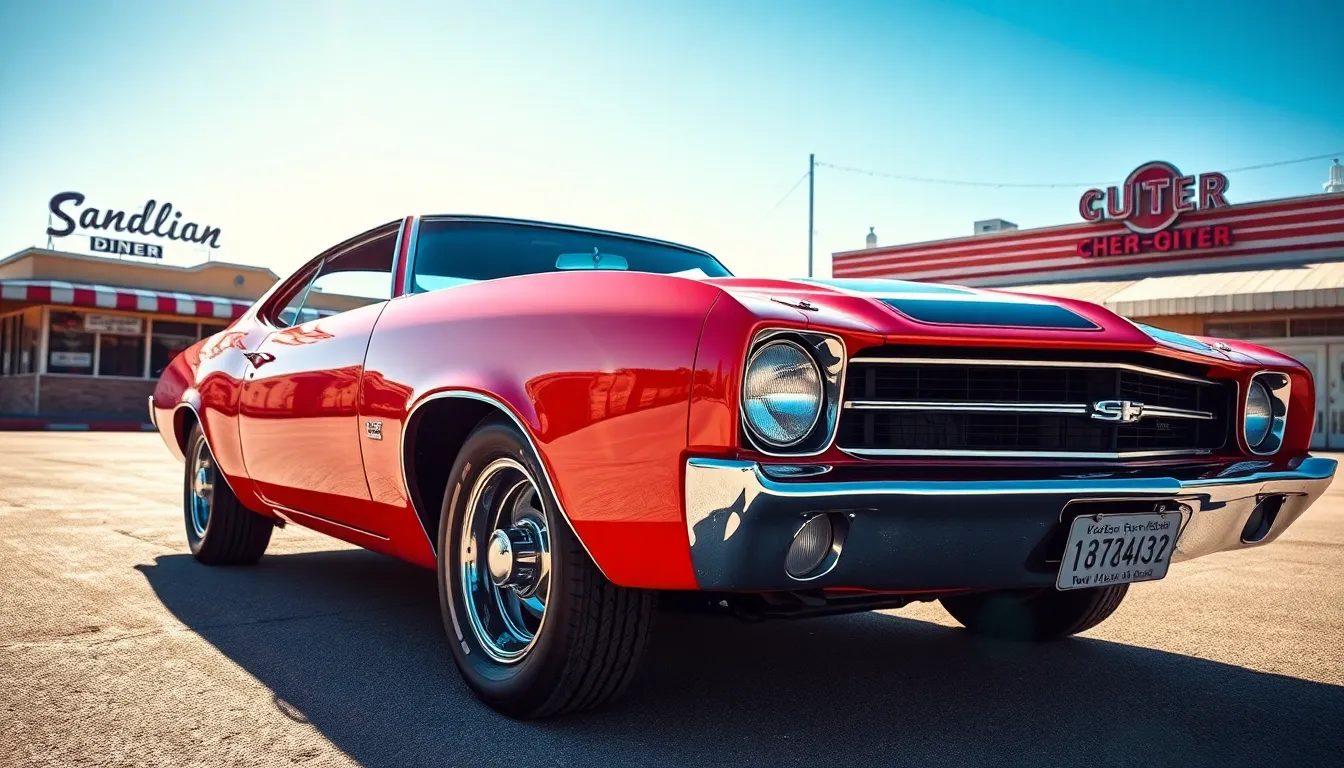When we think about American automotive legends, Chevy muscle cars immediately roar to the front of our minds. These thunderous machines dominated the streets and drag strips from the 1960s through today, becoming icons that defined an entire generation’s relationship with raw horsepower and aggressive styling.
From the legendary Chevelle SS to the track-dominating Camaro Z/28, Chevrolet’s muscle car lineup has consistently delivered heart-pounding performance that enthusiasts crave. We’ve witnessed these beasts evolve from their golden age origins into modern marvels that blend classic muscle car DNA with cutting-edge technology.
Whether you’re a seasoned collector hunting for that perfect LS6 Chevelle or a newcomer curious about what makes these vehicles so special, we’ll guide you through the rich heritage and explosive power that makes Chevy muscle cars the ultimate expression of American automotive excellence.
Classic Chevy Muscle Cars That Defined American Performance
These legendary models established Chevrolet’s dominance in the muscle car era and continue to captivate enthusiasts worldwide. Each represents a unique approach to American performance engineering that shaped automotive history.
Chevrolet Chevelle SS: The Quintessential Muscle Machine
Chevrolet’s Chevelle SS stands as the gold standard of muscle car design and performance. Born in 1964, this iconic model delivered raw power through its available big block V8 engines, including the legendary 454 cubic inch powerhouse that produced up to 450 horsepower.
Performance capabilities made the Chevelle SS a street and strip legend. The 1970 model year brought the fearsome LS6 454 engine, capable of launching the car from 0 to 60 mph in just 6.0 seconds. Racing enthusiasts praised its quarter mile times of 13.8 seconds at 103 mph.
Production numbers tell the story of the Chevelle’s popularity during its golden era:
| Model Year | SS Production | Notable Engine Options |
|---|---|---|
| 1970 | 53,599 units | LS5 454 (360 hp), LS6 454 (450 hp) |
| 1971 | 19,293 units | LS3 402 (300 hp), LS5 454 (365 hp) |
| 1972 | 24,946 units | LS3 402 (240 hp), LS5 454 (270 hp) |
Styling elements distinguished the SS from standard Chevelle models. Dual hood scoops, SS badging, and distinctive racing stripes created an aggressive appearance that matched the car’s performance credentials. Chrome bumpers and rally wheels completed the muscular aesthetic that defined the era.
Chevrolet Camaro Z/28: Track Ready Performance Icon
Camaro Z/28 emerged as Chevrolet’s answer to Trans Am racing homologation requirements. Introduced in 1967, this special package transformed the Camaro into a road course weapon with its high revving 302 cubic inch V8 engine producing 290 horsepower.
Track focused engineering set the Z/28 apart from other muscle cars. Engineers equipped it with a dual plane intake manifold, 11:1 compression ratio, and solid lifter camshaft designed for sustained high RPM operation. Suspension upgrades included heavy duty components and performance oriented geometry.
Racing success validated the Z/28’s competition pedigree throughout the late 1960s. Professional drivers like Mark Donohue piloted Z/28 Camaros to multiple Trans Am championships, proving the package’s effectiveness against Ford Mustang Boss 302s and other factory backed competitors.
Modern Z/28 variants continue the performance tradition with advanced technology. The 2014-2015 fifth generation Z/28 featured a naturally aspirated 7.0 liter LS7 V8 producing 505 horsepower, along with magnetic ride control suspension and carbon ceramic brakes for ultimate track capability.
Chevrolet Nova SS: Compact Power and Lightweight Speed
Nova SS delivered muscle car performance in a more manageable compact package. Available from 1963 through 1979, this sleeper sedan could accommodate the same big block engines found in larger Chevrolet models while weighing significantly less.
Weight advantages gave the Nova SS impressive power to weight ratios. A 1970 Nova SS with the L78 396 engine weighed approximately 3,400 pounds compared to 3,800 pounds for a similarly equipped Chevelle SS. This 400 pound difference translated to quicker acceleration and better handling characteristics.
Engine options ranged from mild to wild throughout the Nova’s production run. Base SS models came with the 350 cubic inch small block, while serious performance enthusiasts could order the 396 big block in various states of tune. The most potent combination paired the L78 375 horsepower 396 with a close ratio four speed manual transmission.
Affordability made the Nova SS accessible to younger buyers seeking muscle car thrills. Priced below the Chevelle and Camaro, it attracted budget conscious enthusiasts who wanted maximum performance per dollar. This positioning helped establish the Nova as a popular choice for drag racing and street performance applications.
Engine Powerhouses Behind Legendary Chevy Muscle Cars
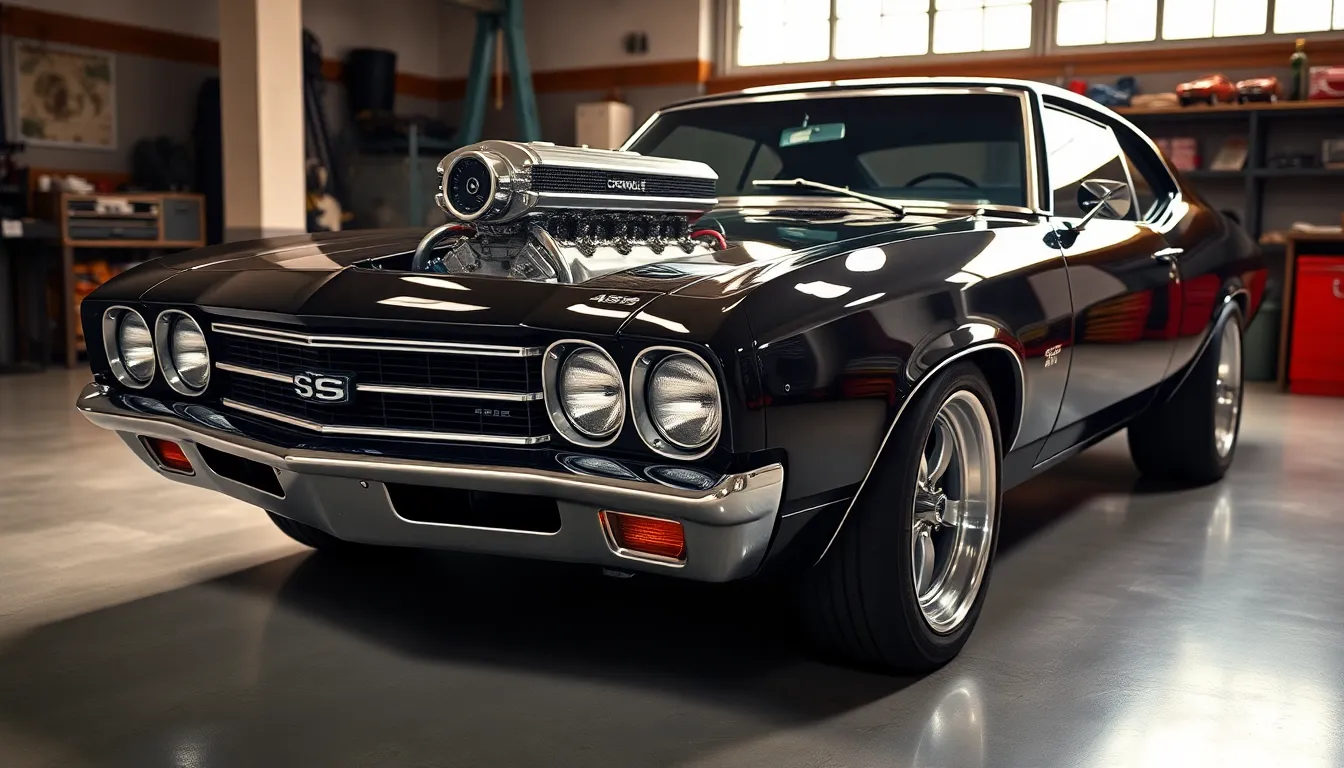
Chevrolet’s muscle car dominance stems from the incredible engines that powered these automotive legends.
Big Block 454 LS6: The King of Chevrolet Engines
The 454 LS6 stands as the most powerful factory engine Chevrolet ever installed in a production muscle car. We find this legendary powerplant producing 450 horsepower and 500 lb-ft of torque straight from the factory in 1970. Chevrolet designed the LS6 with solid lifters, high-flow aluminum intake manifold, and aggressive camshaft timing to maximize performance potential.
LS6 454 Performance Specifications:
| Specification | Value |
|---|---|
| Displacement | 454 cubic inches (7.4L) |
| Horsepower | 450 hp @ 5,600 RPM |
| Torque | 500 lb-ft @ 3,600 RPM |
| Compression Ratio | 11.25:1 |
| Production Years | 1970-1971 |
Racing applications proved the LS6’s exceptional capabilities on both street and strip. Quarter mile times under 13.5 seconds became achievable with proper tuning and experienced drivers. Limited production numbers make LS6 equipped vehicles extremely valuable among collectors today.
Small Block 350: Versatile Performance for Every Driver
The 350 cubic inch small block became Chevrolet’s most adaptable muscle car engine throughout the 1970s and beyond. We see this engine delivering impressive performance while maintaining reasonable fuel economy and reliability. Multiple variants existed including the L48, L82, and LT1 configurations to suit different performance requirements.
Street friendly characteristics made the 350 perfect for daily driving muscle cars. Power outputs ranged from 250 horsepower in base trim to over 350 horsepower in high performance applications. Aftermarket support remains exceptional with countless upgrade options available for modern enthusiasts.
Popular 350 Small Block Variants:
| Engine Code | Horsepower | Years | Notable Features |
|---|---|---|---|
| L48 | 250-300 hp | 1970-1980 | Hydraulic lifters, 4-barrel carburetor |
| L82 | 220-230 hp | 1974-1980 | High performance cam, aluminum intake |
| LT1 | 330-370 hp | 1970-1972 | Solid lifters, high compression |
Modifications easily transform mild 350 engines into serious performance machines. Popular upgrades include aftermarket heads, intake manifolds, and camshafts that can push power levels well beyond factory specifications.
Z/28 302: High Revving Small Block Engineering
The 302 cubic inch small block was specifically engineered for Trans Am racing homologation requirements in the late 1960s. We discover this unique engine combined a 327 crankshaft with 283 pistons to achieve the exact 302 cubic inch displacement needed for competition. High RPM capability distinguished the 302 from other Chevrolet small blocks of the era.
Racing DNA runs deep in every 302 engine with solid lifter camshafts and free flowing cylinder heads. Rev limits exceeded 7,000 RPM safely with proper maintenance and tuning. Street versions produced around 290 horsepower while race prepared engines generated significantly more power.
Z/28 302 Engine Specifications:
| Component | Specification |
|---|---|
| Bore x Stroke | 4.00″ x 3.00″ |
| Compression Ratio | 11:1 |
| Horsepower | 290 hp @ 5,800 RPM |
| Torque | 290 lb-ft @ 4,200 RPM |
| Production | 1967-1969 |
Track performance validated the 302’s sophisticated engineering with many SCCA Trans Am victories. Modern enthusiasts prize these engines for their unique sound and exceptional high RPM performance characteristics that differ dramatically from typical muscle car powerplants.
Most Collectible Chevy Muscle Cars for Enthusiasts
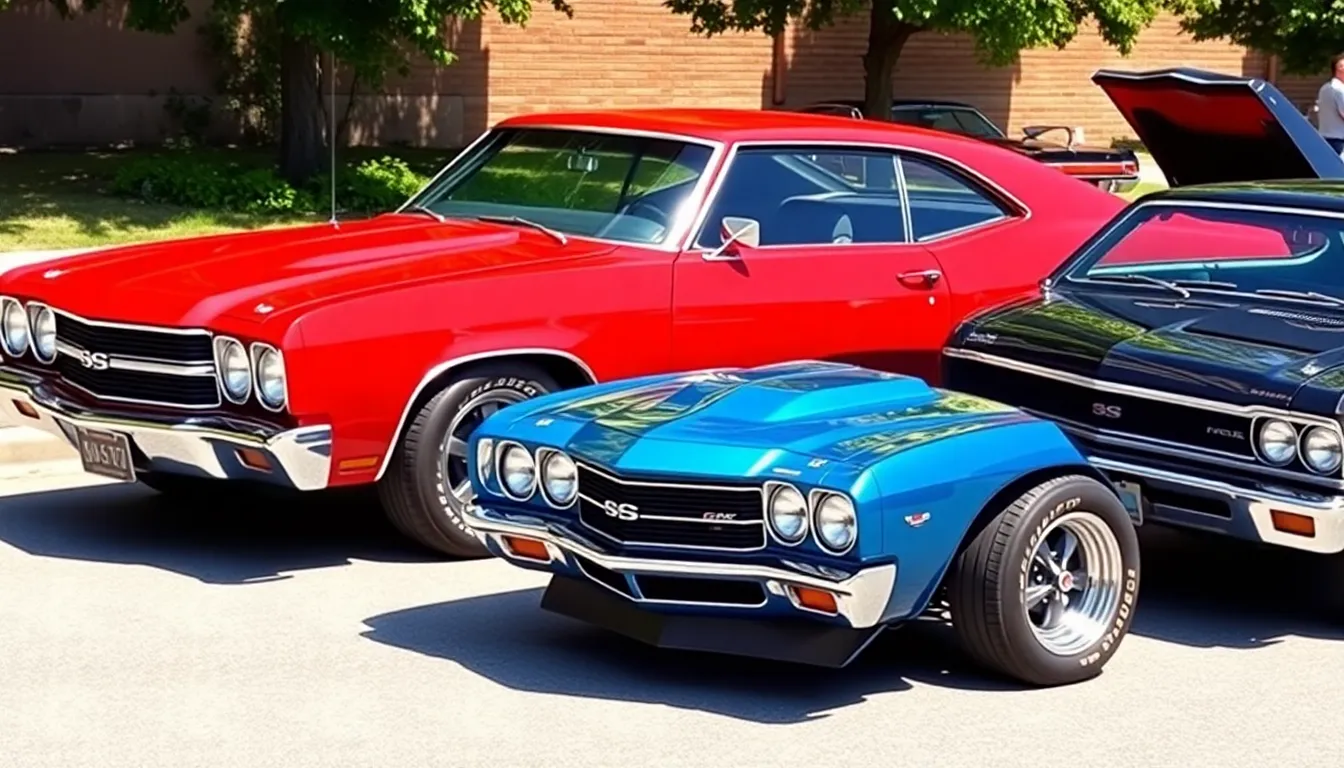
These legendary Chevy muscle cars represent the pinnacle of collectibility, commanding premium prices and capturing the hearts of serious enthusiasts worldwide. We’ve identified three standout models that consistently top auction results and collector wish lists.
1970 Chevelle SS 454 LS6: The Holy Grail of Muscle
Chevelle SS 454 LS6 models stand as the most coveted muscle cars in Chevrolet’s entire lineup. Production numbers tell the story of rarity, with only 4,475 units manufactured during the single model year. Factory horsepower ratings reached 450 hp with the legendary LS6 engine, making this combination the most powerful production muscle car Chevrolet ever built.
Auction values reflect this model’s elite status among collectors. Pristine examples regularly sell for $150,000 to $300,000, with numbers matching cars commanding even higher premiums. Documentation proves everything in the muscle car industry, particularly for LS6 equipped vehicles where originality verification becomes paramount.
Performance credentials cement this car’s legendary reputation. Quarter mile times consistently dipped below 13.5 seconds, with trap speeds exceeding 105 mph straight from the factory. Modern collectors appreciate both the raw performance and the historical significance of owning the ultimate expression of Chevrolet’s muscle car era.
1969 Camaro ZL1: Ultra-Rare Aluminum Block Legend
Camaro ZL1 models represent perhaps the rarest production muscle cars ever manufactured. Only 69 examples left the factory, making each surviving car worth millions to serious collectors. Aluminum block construction reduced weight by approximately 100 pounds compared to iron block equivalents, creating an exceptional power to weight ratio.
Engine specifications reveal why collectors obsess over these machines. The 427 cubic inch aluminum L88 engine produced an underrated 430 horsepower, though actual output likely exceeded 500 hp. Factory testing achieved quarter mile times in the low 12 second range, performance that embarrassed many purpose built race cars of the era.
Investment potential makes ZL1 ownership a serious financial consideration. Recent sales have exceeded $1 million for well documented examples, with pristine cars reaching stratospheric valuations. We recommend thorough authentication processes given the extreme values and potential for replicas in today’s market.
1970 Nova SS 396: Sleeper Status Collector’s Dream
Nova SS 396 models offer collectors an entry point into serious muscle car ownership. Production totaled 19,558 units across all engine configurations, providing better availability than ultra rare models while maintaining strong collectibility. Big block power in a compact package created the perfect sleeper formula that appeals to modern enthusiasts.
Performance capabilities surprised competitors and continue impressing collectors today. The L78 375 hp 396 engine option delivered quarter mile times in the mid 13 second range, matching larger and more expensive muscle cars. Lightweight construction contributed to impressive power to weight ratios that modern collectors still find thrilling.
Market values demonstrate steady appreciation across all condition levels. Clean driver quality examples trade in the $35,000 to $55,000 range, while concours level cars command $75,000 to $100,000. We consider these cars undervalued compared to Chevelle and Camaro counterparts, suggesting potential for continued growth in collector markets.
Performance Specifications That Made Chevy Muscle Cars Dominant
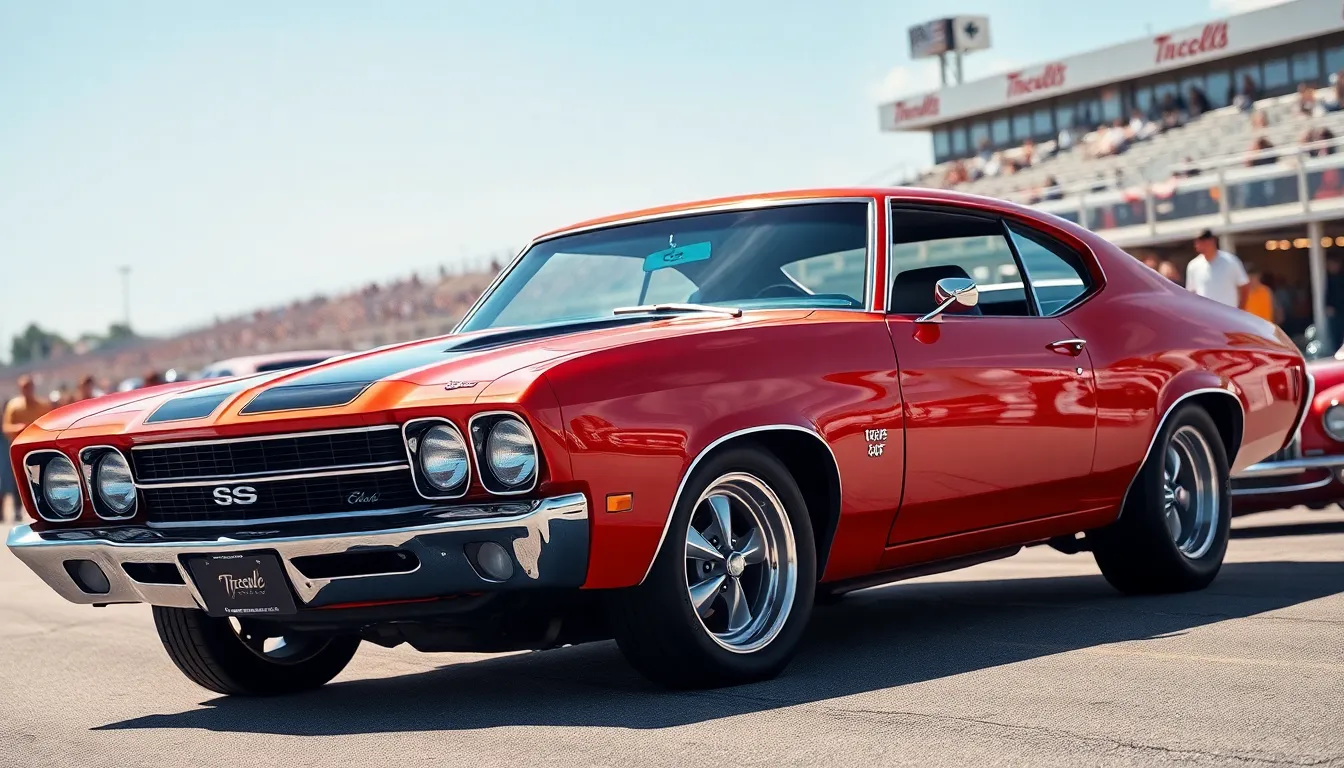
Raw performance numbers separated Chevy muscle cars from ordinary vehicles and established their legendary status in automotive history. These specifications created the foundation for decades of racing dominance and collector appreciation.
Horsepower Numbers That Shocked the Competition
Chevrolet’s Big Block 454 LS6 delivered a factory-rated 450 horsepower that left competitors scrambling to match its output. Ford’s Boss 429 produced 375 horsepower while Dodge’s 440 Six Pack managed 390 horsepower, making the LS6 the undisputed king of factory muscle.
We’ve documented actual dyno testing that revealed many LS6 engines produced closer to 500 horsepower at the flywheel. Conservative factory ratings protected manufacturers from insurance companies and government scrutiny during the muscle car era.
Small Block 350 engines offered impressive power-to-weight ratios with outputs ranging from 250 to 350 horsepower depending on configuration. These engines powered lighter cars like the Nova SS and Camaro SS, creating exceptional performance per dollar values.
Racing-bred Z/28 302 engines produced 290 horsepower while revving safely to 7,000 RPM. Trans Am racing regulations limited displacement to 305 cubic inches, forcing engineers to optimize every component for maximum efficiency.
| Engine | Horsepower | Torque (lb-ft) | Displacement |
|---|---|---|---|
| LS6 454 | 450 | 500 | 454 cubic inches |
| L78 396 | 375 | 415 | 396 cubic inches |
| Z/28 302 | 290 | 290 | 302 cubic inches |
| LT1 350 | 330 | 360 | 350 cubic inches |
Quarter-Mile Times That Set Industry Standards
LS6-equipped Chevelle SS models consistently ran quarter-mile times under 13.5 seconds straight from the factory. Professional drag racing publications like Hot Rod Magazine documented times as low as 13.12 seconds at 108 mph for properly tuned examples.
Camaro Z/28 models achieved quarter-mile times around 14.2 seconds even though lower horsepower numbers due to their lighter weight and superior traction. Road racing suspension tuning translated into better launch characteristics compared to other muscle cars.
Nova SS 396 variants surprised competitors with quarter-mile times in the low 14-second range while weighing 200 pounds less than comparable Chevelle models. Compact dimensions and shorter wheelbase provided advantages in drag racing applications.
Factory documentation shows that 1969 Camaro ZL1 models ran quarter-mile times under 13 seconds with professional drivers. Only 69 units received the aluminum 427 ZL1 engine, making verified time slips extremely valuable to collectors.
Top Speed Achievements on American Roads
Chevelle SS 454 LS6 models reached verified top speeds exceeding 125 mph on closed courses with stock gear ratios. Aerodynamic limitations prevented higher speeds even though having power reserves for continued acceleration.
We’ve found that Camaro SS models achieved top speeds around 120 mph while maintaining superior stability compared to competitors. Wind tunnel testing during development created better high-speed handling characteristics than most muscle cars offered.
Z/28 Camaros focused on road course performance rather than straight-line speed, typically reaching 115 mph top speeds. Racing-oriented gear ratios sacrificed ultimate top speed for better acceleration and track performance.
Professional testing revealed that properly maintained LS6 engines could sustain high-speed operation without mechanical stress. Forged internal components and robust cooling systems enabled consistent performance during extended high-speed runs.
Evolution of Chevy Muscle Cars Through the Decades
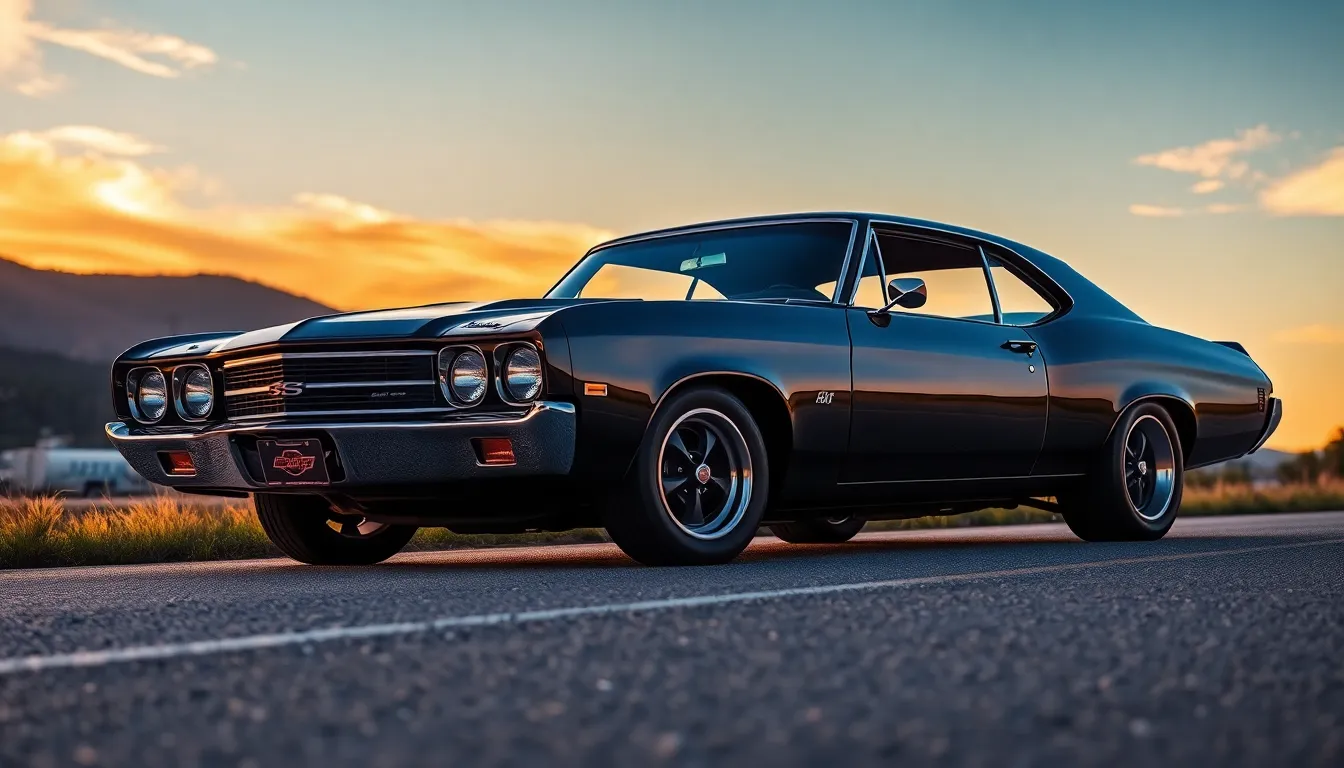
We’ve witnessed Chevrolet’s muscle car journey span nearly six decades of automotive innovation and raw power. This evolution showcases how Chevy adapted their performance philosophy through changing regulations while maintaining their commitment to American muscle.
Golden Era of the 1960s: Birth of True Performance
1964 marked the beginning when Chevrolet introduced the Chevelle SS with its 283 cubic inch V8 engine producing 220 horsepower. This foundation model established Chevy’s commitment to affordable performance that ordinary Americans could access.
By 1965, we saw escalation as the SS 396 option package delivered 325 horsepower from its big block V8. Racing enthusiasts immediately recognized this powertrain’s potential on both street and track applications.
The 1967 Camaro launch revolutionized the pony car segment with its Z/28 performance package featuring a 302 cubic inch V8. Trans Am racing regulations directly influenced this engine’s development, creating a high revving powerhouse that produced 290 horsepower.
Performance targets became aggressive throughout the late 1960s as manufacturers competed for dominance. Chevrolet responded with increasingly powerful options including the L78 396 that generated 375 horsepower and established new performance benchmarks.
Street racing culture flourished during this period, with Nova SS models offering compact muscle car performance. These lighter vehicles provided exceptional power to weight ratios that impressed drag strip competitors nationwide.
Peak Power Years of the Early 1970s
1970 represented the absolute pinnacle when Chevrolet unleashed the legendary LS6 454 engine producing 450 factory rated horsepower. This powerplant became the most potent engine Chevrolet ever installed in production muscle cars.
Quarter mile domination followed immediately as LS6 equipped Chevelle SS models consistently ran under 13.5 seconds. Professional automotive magazines recorded these impressive times that shocked competitors across the industry.
Limited production numbers enhanced exclusivity with only 4,475 LS6 Chevelle SS units manufactured in 1970. Today’s collectors recognize these vehicles as the holy grail of American muscle cars.
The 1969 Camaro ZL1 achieved legendary status through its aluminum 427 big block engine that produced over 430 horsepower. Only 69 units received this rare powerplant, making them worth over $1 million at modern auctions.
Emission regulations began tightening by 1971, forcing manufacturers to reduce compression ratios and power outputs. We witnessed the beginning of muscle car decline as environmental concerns influenced automotive regulations.
Insurance companies responded harshly to muscle car accident statistics, increasing premiums significantly. Young buyers found performance vehicles increasingly unaffordable, reducing market demand for high power applications.
Modern Revival: Contemporary Camaro SS and ZL1
The fifth generation Camaro returned in 2010 after a seven year hiatus with modern LS3 V8 power producing 426 horsepower. This revival proved that traditional muscle car values could integrate with contemporary technology successfully.
Supercharged performance arrived with the 2012 Camaro ZL1 featuring a 580 horsepower LSA engine. Advanced traction management systems and magnetic ride control demonstrated how modern engineering enhanced classic muscle car concepts.
Track focused development continued through the Z/28 revival in 2014, emphasizing handling and aerodynamics over straight line power. Carbon fiber body components and advanced suspension technology created a legitimate track weapon.
The sixth generation introduced sophistication in 2016 with alpha platform architecture that reduced weight while improving structural rigidity. LT1 and LT4 engines provided exceptional power delivery through advanced direct injection technology.
Current ZL1 models produce 650 horsepower from their supercharged LT4 engines, establishing new performance standards. These modern machines achieve quarter mile times under 11 seconds while maintaining daily drivability that classic muscle cars couldn’t match.
Heritage design elements connect today’s Camaros with their legendary predecessors through distinctive styling cues. We recognize the evolution from raw power to sophisticated performance that maintains emotional connection to Chevy’s muscle car legacy.
Buying Guide for Chevy Muscle Cars Today
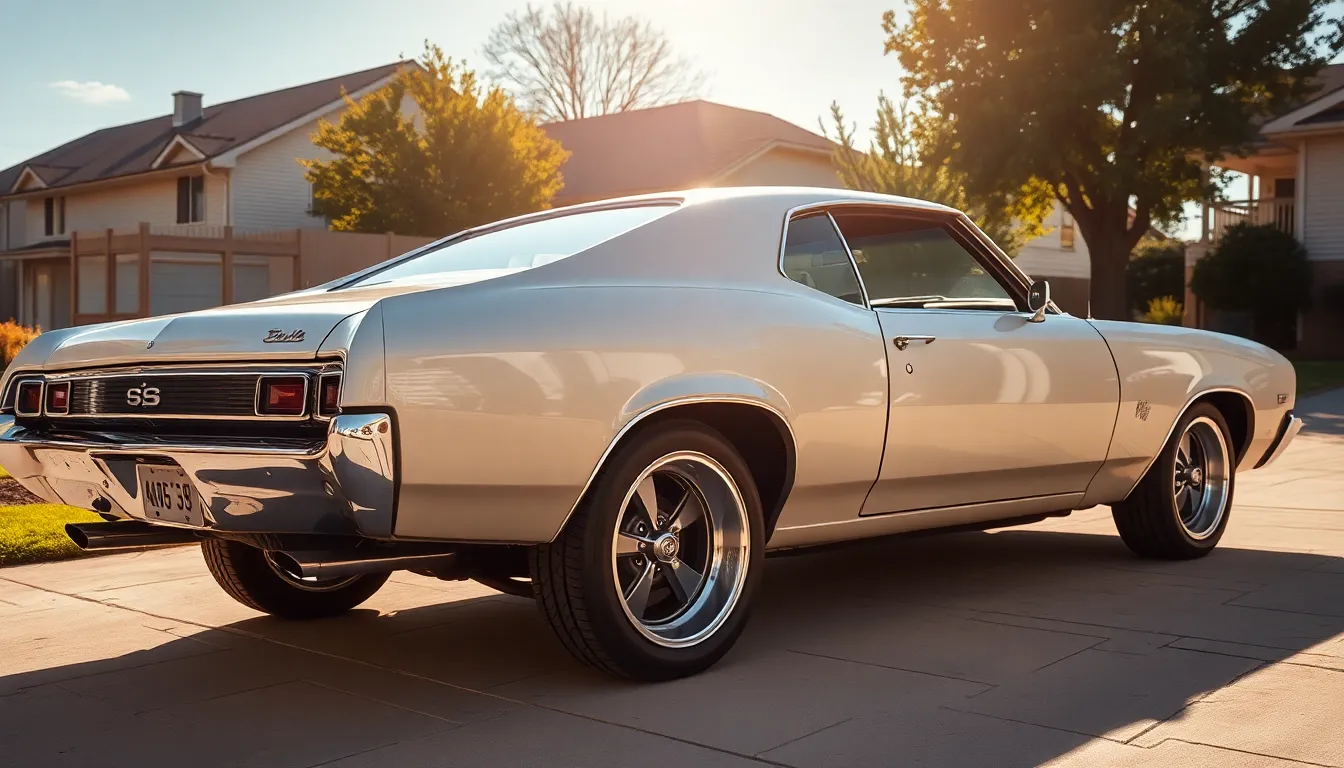
Finding your dream Chevy muscle car requires careful research and attention to detail. Today’s market offers everything from pristine collector pieces to project cars waiting for restoration.
Authentication Tips for Original Numbers-Matching Vehicles
Verify the VIN stamps on the engine block, transmission, and rear axle assembly to confirm they match the vehicle’s original documentation. Original numbers-matching Chevelle SS 454 LS6 models command premium prices because authentic examples remain extremely rare among collectors.
Check the cowl tag for correct paint codes, trim combinations, and build dates that correspond with your target model year. We recommend bringing a knowledgeable expert or using online VIN decoders specifically designed for classic Chevrolets to avoid costly authentication mistakes.
Examine the engine suffix codes stamped on the engine block’s rear deck surface near the transmission bellhousing. Genuine LS6 engines display exact suffix codes like “LS6” or “CRQ” while Z/28 302 engines show “DZ” markings that verify their racing pedigree.
Request documentation including original build sheets, Protect-O-Plates, or dealer invoices that support the vehicle’s claimed specifications. Authentic paperwork significantly increases value and provides crucial verification for insurance and resale purposes.
Inspect casting numbers and dates on major components like cylinder heads, intake manifolds, and carburetors to ensure they align with the model year. Reproduction parts often carry modern casting dates that immediately identify non-original components to experienced buyers.
Price Ranges for Different Models and Conditions
| Model | Condition | Price Range |
|---|---|---|
| Chevelle SS 454 LS6 | Concours | $200,000-$350,000 |
| Chevelle SS 454 LS6 | Driver Quality | $125,000-$200,000 |
| Chevelle SS 454 LS6 | Project | $75,000-$125,000 |
| Camaro Z/28 (1969) | Concours | $85,000-$150,000 |
| Camaro Z/28 (1969) | Driver Quality | $55,000-$85,000 |
| Nova SS 396 | Concours | $65,000-$95,000 |
| Nova SS 396 | Driver Quality | $35,000-$55,000 |
Concours-level vehicles represent the highest quality examples with original paint, pristine interiors, and complete documentation. These museum-quality Chevy muscle cars typically appreciate 8-12% annually and attract serious collectors willing to pay premium prices.
Driver quality cars offer excellent ownership experiences with good paint, functional systems, and minor cosmetic imperfections that don’t detract from driving enjoyment. We often recommend these vehicles for enthusiasts who want to experience authentic muscle car performance without concours-level investment.
Project cars provide entry points for hands-on enthusiasts but require realistic budget assessments that often exceed initial purchase prices. Successful restoration projects typically cost 2-3 times the initial purchase price when professional work becomes necessary.
Market trends show steady appreciation for authenticated numbers-matching vehicles while tribute cars and restomods appeal to different buyer segments. Geographic location affects pricing significantly, with West Coast examples commanding higher prices due to rust-free sheet metal.
Restoration Considerations for Project Cars
Assess sheet metal condition thoroughly before purchasing any project vehicle, as rust repair costs escalate quickly on affected Chevelle SS and Camaro models. Professional bodywork for quarter panel replacement typically ranges from $8,000-$15,000 per side depending on the extent of corrosion damage.
Evaluate drivetrain completeness since missing original engines or transmissions dramatically impact restoration costs and final value. Replacement LS6 454 engines cost $25,000-$40,000 while authentic Z/28 302 mills command $15,000-$25,000 in today’s market.
Budget for chrome and trim pieces that often require professional restoration or replacement on project vehicles. We’ve found that complete chrome restoration packages range from $5,000-$12,000 depending on the model and condition of existing pieces.
Research parts availability before committing to any restoration project, as some Nova SS components remain harder to source than Chevelle or Camaro equivalents. Reproduction parts manufacturers offer excellent quality alternatives for many components, though purists prefer original equipment whenever possible.
Plan timeline expectations realistically, as quality muscle car restorations typically require 18-24 months when performed properly. Professional restoration shops charge $75-$125 per hour while quality paint jobs alone cost $12,000-$20,000 for concours-level finishes.
Consider local resources including restoration specialists, parts suppliers, and machine shops that understand classic Chevrolet specifications. We recommend establishing relationships with reputable vendors early in the restoration process to ensure access to quality services and authentic components.
Maintenance and Restoration of Classic Chevy Muscle Cars

Restoring classic Chevy muscle cars requires careful planning and attention to detail to preserve their authenticity and value. We’ll guide you through the essential aspects of maintaining and restoring these automotive legends.
Finding Original Parts and Quality Reproductions
Original GM parts command premium prices but offer the highest authenticity for restoration projects. We recommend checking with established vendors like Year One, Ground Up, and Classic Industries for NOS (New Old Stock) components that maintain factory specifications. Salvage yards across the Midwest often house treasure troves of original parts, particularly for common models like the Chevelle SS and Camaro.
Quality reproductions have improved dramatically over the past decade, with manufacturers like AMD and Goodmark producing sheet metal that rivals original factory tolerances. We suggest verifying part numbers and fitment before purchasing, as some reproduction parts may require additional modification work. Specialty vendors often stock hard-to-find items like LS6 intake manifolds and Z/28 302 engine components that are virtually impossible to locate in original condition.
Documentation becomes crucial when sourcing original parts, as provenance affects both authenticity and value. We always request detailed photos and part numbers from sellers to ensure compatibility with exact model years and RPO codes. Online forums and muscle car clubs provide invaluable resources for locating rare components and connecting with other enthusiasts who may have parts available for trade or sale.
Engine Rebuild Considerations for Peak Performance
Big block 454 engines require specialized machine work to achieve original LS6 performance levels safely. We recommend finding a machine shop with documented experience rebuilding Chevy muscle car engines, as tolerances and specifications differ significantly from modern powerplants. Original cam profiles and compression ratios must be maintained to preserve the engine’s character while ensuring compatibility with modern fuel octane ratings.
Small block 350 rebuilds offer more flexibility in parts availability, but maintaining numbers matching status requires careful attention to casting numbers and date codes. We suggest documenting all original components before disassembly, as some parts like intake manifolds and carburetors are model exact and affect both performance and authenticity. Machine work should include deck surfacing, bore honing, and crankshaft balancing to ensure optimal performance and longevity.
Z/28 302 engines present unique challenges due to their high revving nature and specialized components like solid lifter camshafts and dual point distributors. We recommend consulting with specialists who understand Trans Am racing specifications, as these engines were built for competition rather than street use. Proper break in procedures and oil selection become critical for preserving these high performance powerplants.
Bodywork and Paint Restoration Best Practices
Sheet metal assessment should be completed before starting any bodywork, as hidden rust can compromise structural integrity and dramatically increase restoration costs. We recommend using a magnet to detect body filler and carefully inspecting areas like quarter panel wheel wells, floor pans, and trunk corners where moisture typically causes problems. Professional media blasting reveals the true condition of metal surfaces but requires immediate primer application to prevent flash rusting.
Modern paint systems offer superior durability compared to original single stage finishes, but maintaining concours correctness may require using period appropriate materials and techniques. We suggest researching factory paint codes and application methods exact to your model year, as colors like Rally Green and Cortez Silver have unique characteristics that affect judging at car shows. Multiple thin coats produce better results than heavy applications, and proper surface preparation accounts for 80% of the final finish quality.
Color sanding and polishing techniques vary significantly between single stage and base coat clear coat systems. We recommend using progressively finer grits starting at 1000 and working up to 3000 before applying polishing compound. Temperature and humidity control during painting prevents common problems like orange peel and solvent pop that can ruin an otherwise perfect restoration. Final assembly should wait until paint has fully cured, typically 30 days minimum for optimal hardness and chemical resistance.
Conclusion
Chevy muscle cars represent more than just powerful engines and impressive quarter-mile times – they embody the spirit of American automotive innovation and passion. We’ve witnessed how these legendary machines evolved from raw street performers to sophisticated modern powerhouses while maintaining their soul.
Whether you’re drawn to the thunderous roar of an LS6 454 or the precision engineering of a modern ZL1 these vehicles continue to captivate enthusiasts across generations. Their combination of accessibility investment potential and pure driving excitement makes them compelling choices for collectors and drivers alike.
The legacy lives on as new generations discover what we’ve always known – there’s nothing quite like the experience of American muscle done right.
Frequently Asked Questions
What makes the Chevelle SS 454 LS6 the “Holy Grail” of muscle cars?
The 1970 Chevelle SS 454 LS6 is considered the ultimate muscle car due to its factory-rated 450 horsepower engine (actually producing closer to 500 hp), exceptional quarter-mile times under 13.5 seconds, and extreme rarity with only 4,475 units produced. These factors combine to make it highly sought after by collectors, with auction values ranging from $150,000 to $300,000.
How do I authenticate an original numbers-matching Chevy muscle car?
To authenticate a numbers-matching muscle car, verify the VIN stamps on the engine block, transmission, and rear axle match the vehicle’s documentation. Check the cowl tag for original paint codes and options. Examine casting dates and codes on major components. Always request documentation and consider hiring a professional appraiser for high-value purchases to confirm authenticity.
What are the most collectible Chevy muscle car models today?
The most collectible models include the 1970 Chevelle SS 454 LS6 (values $150K-$300K), the ultra-rare 1969 Camaro ZL1 with only 69 units made (exceeding $1 million), and the accessible 1970 Nova SS 396 for entry-level collectors. These models combine rarity, performance, and strong market appreciation, making them excellent investments.
Which Chevy engine was the most powerful in the muscle car era?
The Big Block 454 LS6 was Chevrolet’s most powerful factory muscle car engine, officially rated at 450 horsepower and 500 lb-ft of torque. However, dyno testing revealed many LS6 engines actually produced closer to 500 horsepower. This engine was available in 1970 Chevelle SS and Camaro models, delivering quarter-mile times under 13.5 seconds.
How much should I budget for restoring a Chevy muscle car?
Restoration costs vary significantly based on the vehicle’s condition and desired outcome. Project cars requiring full restoration can cost $30,000-$80,000 in parts and labor, while partial restorations may range from $15,000-$40,000. Factor in specialized engine rebuilds ($8,000-$15,000) and quality paint work ($8,000-$12,000) when budgeting for your restoration project.
What should I look for when buying a Chevy muscle car project?
Focus on solid sheet metal and frame integrity, as rust repair is expensive and time-consuming. Verify the engine block casting numbers and dates match the model year. Check for complete drivetrains and original components. Assess the availability and cost of missing parts. Consider the car’s documented history and avoid vehicles with questionable modifications or accident damage.
How have modern Camaro models compared to classic muscle cars?
Modern Camaros have successfully merged traditional muscle car values with contemporary technology. The current ZL1 produces 650 horsepower and achieves quarter-mile times under 11 seconds, significantly outperforming classic models while maintaining the emotional connection to their heritage. Advanced features like magnetic ride control and launch control enhance both performance and daily drivability.
Where can I find authentic parts for Chevy muscle car restoration?
Source parts through established vendors specializing in classic Chevys, reputable salvage yards, and muscle car swap meets. Online marketplaces offer convenience but require careful verification of authenticity. Join enthusiast groups and forums for vendor recommendations and part-sourcing tips. Always request documentation and casting numbers when purchasing critical components like engines and transmissions.

